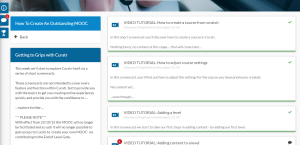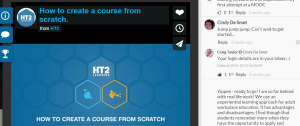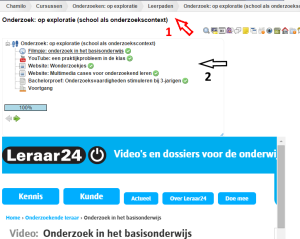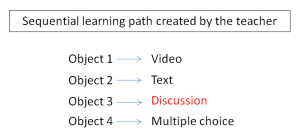Note: Please consider also reading the previous posts where I tackled the conceptual framework of learning paths and tested these ideas against the traditional LMS.
I was able to try out the Curatr MOOC software by HT2. They organised a free MOOC, explaining their vision on social learning. In addition all participants were offered the opportunity to create their own MOOC.
Can we compare learning paths within a traditional LMS with the learning steps within Curatr?
The screenshot above shows that we can compare learning paths within an LMS with the learning steps within Curatr (see the green line under each object).
Can we use software such as Curatr to benefit from the new learning path design you described in the previous post?
The software I’m looking for needs to help us in our effort to tackle the diverse student inflow, while Curatr is used by companies to train employees via social learning. So it wouldn’t be fair to compare both learning environments. However, I made the following remarks using Curatr:
- The learning paths are still sequentially structured, but without the static designs and non-dynamic user-experiences we experienced in our LMS.
Curatr – LMS: 1 – 0 - The content is still structured by the teacher, the system unfortunately doesn’t allow students to add their own content.
No extra points - In my experience, a big plus is the fact all learning objects can be discussed and receive likes at the object level. Adding annotations would make it even better.
Curatr – LMS: 2 – 0 - In addition, I found Curatr to be very easy to work with, as an administrator and as a student.
Curatr – LMS: 3 – 0 - The biggest advantage in favor of Curatr are their MOOC wranglers (or facilitators).
Curatr – LMS: 4 – 0
I enjoyed playing with Curatr and was able to re-use the learning objects I created within my own teaching. And even better: I obtained my first CPD certificate of achievement.




